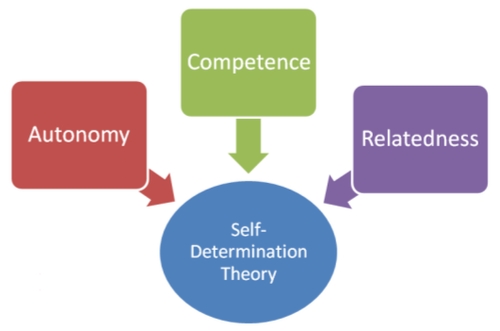Previously I talked about The Relationship Building Process with regards to an article released by the New York Times on Google’s Project Aristotle. The focus of that post was on how strong relationships, that can be measured on a scale we call The Relationship Building Process, enhance a team’s productivity. In this post, I want to take the focus away from relationships and shine a light on the individual.
Indeed The Relationship Building Process helps build motivation in individuals, but looking at it from a different point of view will help to explain how, and bring up some of the other ways in which an individual’s motivation can be nurtured. So instead of solely looking at a team’s dynamics, and how they help build a “super team”, we will look at what elements will help make everyone on a team motivated as an individual, to increase productivity.

Self-Determination Theory (SDT) was developed by Richard M. Ryan and Edward L. Deci. It states, that an individual is motivated by three psychological needs: (1) Conceived autonomy, (2) a sense of belonging (to a group) and (3) competence. Nurturing to these three needs will grow an individual’s motivation. An individual who feels fulfilled in these three needs has also been observed to handle stress better. Now the second pillar in this group can be clearly seen to tie in with strong relationships and a healthy group dynamic. Building strong relationships helps people to feel part of the group. But doesn’t intensifying a group’s bonds decreased the level of autonomy for the individuals? This is perhaps an aspect of leadership and teamwork that is often missed by people.
Letting people in to a group is about supporting them, but also about respecting them. That’s the first step in our Relationship Building Process. An individual feels autonomous, when they are trusted to make decisions on their own. They are encouraged to have their own, autonomous, opinion. That opinion is listened to.
Often leaders are viewed as having to make the decisions. Good leadership is getting your team to do what is required of them. A good team, with a good leader, might even get good results even with a very controlling leadership style. But you are leaving out one of the three psychological needs, and the team will most likely feel less motivated to work towards the goals it is set. Allowing everyone to voice their opinions might intuitively feel like something that will slow the team down. Too many people chiming in might seem like a needless deterrent. However, the end result of this is in fact an increase. Just as Project Aristotle found that teams who spent the first 15 minutes of their meetings chitchatting and not maximizing the time spent on planning, Taking the extra time to hear out all the suggestions made will just make people more motivated to work. When they are motivated, they want to get the team towards their goal. That way they will be more inclined to find and follow the path towards that goal. The goal, not the path, is what a leader needs to set.
The third psychological need is of course competence. This means that a person feels able to accomplish the tasks set to him. Competence can be divided up into inner and outer confidence. It is one for the individual to feel confident in his skills, but not receiving positive feedback from one’s surroundings can make you doubt yourself. This means that acknowledging a teammate’s competence is crucial. Too often people want to appear competent themselves, and they avoid or even downplay other people’s achievements. This intertwines with hearing out differing opinions, and most importantly admitting if you are wrong or identifying that another team member knows better.
How about a person who clearly has no competence? How can you support an employee who is still learning, and motivate that person to become better and work for the team? Paul Hersey developed what is called Situational Leadership, and it is composed of four different leadership styles, depending on the level of competence of the individual. Although this is with regards to leadership, it can just as well e viewed as a model for peer to peer support.

S1 depicts a person with unconscious incompetence. S2 depicts someone with conscious incompetence. S3 is unconscious and S4 conscious competence. As you can see from the graph, depending on the level of competence a leader needs to be directive, supportive or neither at all. Competence is just as much a social as an individual aspect. The key is that the person feels capable to confront the obstacles set by his environment. This can be that the person knows how to act, or that he has received clear instruction on exactly what he should be doing.
In fact all three of these needs tend to support each other. Take autonomy and the sense of belonging as examples. Being autonomous means having the right to throw out ideas and question those of others. At the same time, that action is a test of the group’s relationships and dynamics. A group with strong relationships will feel “safe” giving out even the craziest of ideas, and thus its members will have a strong sense of belonging. Autonomy and competence go hand in having, albeit slightly dependent on the individual’s inner competence. A competent person has the tools necessary to act autonomously. And as was stated above, Competence is partly a social factor, and a tighter knit group will produce stronger confidence together.
In the last post we viewed at team-based productivity as a social factor, focusing on the need for strong relationships between individuals. I’m hoping this post will help to understand how strong relationships affect individuals, and how it is important to observe every individual’s differences, and adjust accordingly, to help nurture motivation and productivity.
